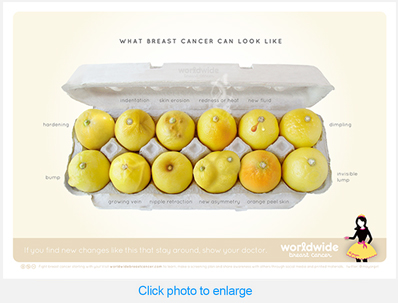
Signs and Symptoms of Breast Cancer
When it comes to breast cancer, time is of the essence.
Breast cancer strikes 1 out of every 8 women, yet only 1 out of 36 women ultimately die from breast cancer. The main difference between being diagnosed with breast cancer and dying from breast cancer is simple-early detection. Early detection means that the cancer has been diagnosed before it has had a chance to spread beyond the breast.
Women with early detected cancers have excellent long term survival. For example, a woman diagnosed with breast cancer the size of a dime or smaller has better than a 95% chance of being cured using simpler treatments with fewer side effects.
 What are the signs symptoms of breast cancer?
What are the signs symptoms of breast cancer?
You know your breasts better than anybody else—even better than your doctor. So if you notice any of the following, you should see your doctor for an examination:
- Breast Lump
- Hardening of the breast
- Strange indentations that haven’t been there before
- Skin erosion
- Redness or heat
- Dimpling
- Thickening of the skin (like an orange peel)
- Fluid leaking from the nipple
- New-onset retraction of a nipple
- Schedule Mammogram
The above image from www.worldwidebreastcancer.com may help you understand exactly what changes to look for.
The Los Angeles Center for Women's Health offers mammography, ultrasound, and breast MRI for evaluation of breast problems. Call (213) 742-6400 to schedule an appointment or use InQuicker, our online scheduling tool.
Need help paying for a mammogram?
Through our grant with the Susan G. Komen Foundation of Los Angeles, we can cover the costs for a full range of diagnostic services, including mammograms, to approximately 100 uninsured or under-insured symptomatic women under age 40 who reside in Los Angeles County.To find out if you may be eligible to enroll in the Breast Cancer Diagnostic Program, please call (213) 742-6400.
Who is at risk?
Breast cancer is among the most frequently diagnosed cancers among women of every racial group in Los Angeles. It's a disease that doesn't discriminate, attacking all ages and all ethnicities. Caucasian women have the highest rates of breast cancer, followed by African American women, Hispanic women, Asian women and Native American women. Despite this difference, everyone benefits from early detection.
Understanding breast density and cancer risk
Breast density describes the types of tissue that make up the breast. There are actually three tissues: glandular, fibrous connective and fatty. The amount of each varies in each woman, but women with more fibrous connective and glandular tissue than fatty tissue have greater breast density making it difficult for a radiologist to see a breast cancer tumor on a mammogram.
What is breast density and what does it have to do with your cancer risk?
Breast density describes the types of tissue that make up the breast. There are actually three tissues: glandular, fibrous connective and fatty. The amount of each varies in each woman, but women with more fibrous connective and glandular tissue than fatty tissue have greater breast density making it difficult for a radiologist to see a breast cancer tumor on a mammogram.
Breast density decreases as you age, but if you have dense breast tissue, it will remain that way throughout your life. If you have dense breasts, you also have a higher risk of developing breast cancer.
How dense are your breasts?
Breast density is classified using a scoring method developed by the American College of Radiology:
- Level 1 = Entirely fatty tissue; less than 25% density
- Level 2 = Scattered fibrograndular densities; less than 25-50% density
- Level 3 = Heterogeneously dense; 50-75% density
- Level 4 = Extremely dense; greater than 75% density
The California Law Breast Density Law
As of April 2013, doctors and health facilities are required to inform you of four (4) important things:
- You will be informed of your personal level of breast density;
- You will be informed that dense breasts can make it harder to evaluate the results of your mammogram;
- That dense breast tissue increases your risk of breast cancer;
- Women with Level 3 or Level 4 breast density should consider supplemental imaging in addition to mammography to improve breast cancer detection. Examples of supplemental imaging include breast MRI and screening ultrasound.
At the Los Angeles Center for Women's Health, women undergoing screening mammography are offered discounted pricing for supplemental imaging to make breast cancer screening comprehensive, convenient and affordable. Our radiologist will help you decide what kind of supplemental imaging is right for you.
For information and appointments, please call (213) 742-6400.
For a Physician Referral, call (888) 742-2462 or use our online feature, Find a Doctor.
